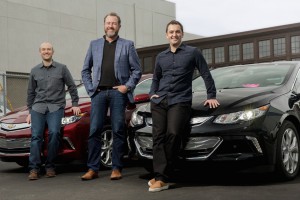
GM CEO Mary Barra said the company is pushing toward zero crashes and zero congestion with its driverless vehicles.
General Motors wants to pull drivers out of some of its cars in a bit to leapfrog competitors like Ford and Google spin-off Waymo. The U.S. automotive giant told Wall Street analysts meeting in Detroit Thursday that it wants to launch a self-driving ride-sharing fleet by 2019.
Though autonomous technology is coming online fast, that’s well ahead of the timetable that many analysts had expected until recently. And it could lead to massive changes not only in how people drive but who drives. Ride-sharing leaders like Lyft and Uber have predicted that with driverless vehicles the cost of their services will drop to the point they will be far cheaper, per mile, than what it costs to own and operate a personal vehicle. And then there are the potential safety and congestion benefits.
“We’re aiming for a future of zero crashes, zero emissions and zero congestion,” GM CEO Mary Barra said.
What was once a fringe technology has become mainstream in recent years, with virtually every manufacturer – and numerous auto suppliers and tech ventures working on self-driving vehicles. The general consensus has been that the technology would debut with semi-autonomous features, such as Tesla’s Autopilot and the Super Cruise system just launched on the Cadillac CT6 sedan.

Lyft founders Logan Green, left, and John Zimmer, right, and GM President Dan Ammann, who believes Lyft will play a critical role in driverless transportation.
Super Cruise allows hands-free operation on well-marked, limited-access highways. The next step is to allow drivers to take their hands off the wheel in a broader range of situations. The ability to take the human out from behind the wheel entirely had generally been expected to take at least another decade of development.
But there has been growing skepticism about the ability of humans to take over driving duties in the event of a crisis, at least quickly enough to prevent a crash. So, a growing number of development programs have shifted focus to full driverless operation. Ford, for one, has promised to put its first such vehicle into production by 2021.
(Barra commits to 1M EVs on roads worldwide by 2020. For more, Click Here.)
Waymo, meanwhile, has been operating an autonomous ride-sharing pilot program in Phoenix and is preparing to go fully driverless. During an appearance at the Los Angeles Auto Show this week, its CEO John Krafcik suggested that program would be rolled out to other cities soon afterwards. But the Google spinoff has been vague about timing and full commercialization efforts.

Waymo CEO John Krafcik said the company is in the testing phase of its autonomous ride-sharing program, but wouldn't commit to a starting date.
For its part, GM has already invested heavily in Lyft and indicated it would supply that service with products such as its battery-electric Chevrolet Bolt EV. It is unclear if GM will launch real-world operation of its planned driverless vehicle through Lyft or find an alternative outlet. The company also operates Maven, a car-sharing program launched last year.
The drive to autonomous and fully driverless vehicles has an appeal to both the head and heart, said Gil Pratt, the head of the Toyota Research Institute, during his own L.A. Auto Show presentation. There are the emotional benefits of reducing highway deaths and cutting congestion. But there’s also the rational benefit of cutting driving costs..
Ride-sharing services, he noted, are demanding the technology. The typical Uber ride costs $1.50 a mile today compared with the $0.85 the average motorist spends in terms of vehicle ownership and operation. It’s expected that by pulling the driver out of the vehicle and then running driverless cars close to 24/7 costs would drop substantially.
(Click Here for details about why half of vehicles on U.S. roads will be electrified by 2030.)
A new study by the Boston Consulting Group forecasts that by 2030 more than 20% of the miles Americans clock on the road each year could be in driverless vehicles operated by ride-sharing services. There is a growing consensus that millions of Americans, especially in denser urban areas, will wind up going car-less. The question is how that will impact an industry that has counted, for more than a century, on ever-increasing sales.
The driverless vehicle era is expected to coincide with explosive growth in sales of electrified vehicles. The BCG study anticipates hybrids, plug-ins and pure-battery-electric vehicles will collectively account for half the private vehicles sold in the U.S. by 2030. About 20% of the volume will be pure BEV and, of those, half will go to ride-sharing services.
The tech revolution has been making for strange bedfellows. GM has not only invested in Lyft but also purchased or partnered with companies like San Francisco-based autonomous vehicle software developer Cruise Technologies. Ford has made similar moves and even bought a company producing the LIDAR – or high-res laser sensor – technology expected to be essential to autonomous and driverless systems.
Some observers remain skeptical, especially considering the industry will invest at least $100 billion in autonomous technology and electrification during just the next five years. But automakers insist that whoever dominates this brave new world will own the auto industry of the future.
(Fewer autos will drive more miles and use more oil by 2040, study says. Have a look, Click Here.)
“It’s a big opportunity,” GM President Dan Ammann told Reuters this week. “We think it will change the world.”
